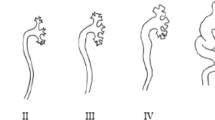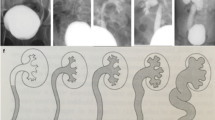Abstract
Purpose of Review
This review will examine the current literature regarding cutaneous vesicostomy use in the pediatric population. We will discuss the various indications for vesicostomy, currently used surgical techniques, and clinical outcomes pertinent to each population.
Recent Findings
The literature on pediatric vesicostomy is sparse and largely limited to retrospective series. The procedure plays a role in a variety of diagnoses, further making the vesicostomy population heterogeneous and the data difficult to interpret. However, vesicostomy has undeniably been shown to provide rapid and reliable bladder drainage leading to improvements in renal function, upper urinary tract dilation, and vesicoureteral reflux in most patients. Although initially thought of as a temporary option for young patients, more recent studies highlight the potential for vesicostomy as a long-term option, even in select older patients.
Summary
Overall, vesicostomy has proven over the years to be a reliable and safe form of urinary diversion. As we learn more about which populations benefit from vesicostomy, we may see its use expand from a temporizing measure to a permanent form of diversion.
Similar content being viewed by others
Abbreviations
- CIC:
-
Clean intermittent catheterization
- LUT:
-
Lower urinary tract
- PUV:
-
Posterior urethral valves
- UTI:
-
Urinary tract infection
- VUR:
-
Vesicoureteral reflux
- y:
-
Year
References
Papers of particular interest, published recently, have been highlighted as: • Of importance
Blocksom BH Jr. Bladder pouch for prolonged tubeless cystostomy. J Urol. 1957;78(4):398–401. https://doi.org/10.1016/S0022-5347(17)66453-X.
• Duckett JW Jr. Cutaneous vesicostomy in childhood. The Blocksom technique. Urol Clin North Am. 1974;1(3):485–95. Most commonly cited description for operative technique in children.
Beland GA, Weiss RM. Cutaneous vesicostomy in children. J Urol. 1965;94:128–31. https://doi.org/10.1016/S0022-5347(17)63586-9.
Noe HN, Jerkins GR. Cutaneous vesicostomy experience in infants and children. J Urol. 1985;134(2):301–3. https://doi.org/10.1016/s0022-5347(17)47134-5.
Bruce RR, Gonzales ET Jr. Cutaneous vesicostomy: a useful form of temporary diversion in children. J Urol. 1980;123(6):927–8. https://doi.org/10.1016/s0022-5347(17)56196-0.
Kim SJ, Jung J, Lee C, Park S, Song SH, Won HS, et al. Long-term outcomes of kidney and bladder function in patients with a posterior urethral valve. Medicine (Baltimore). 2018;97(23):e11033. https://doi.org/10.1097/MD.0000000000011033.
Lee MW, Greenfield SP. Intractable high-pressure bladder in female infants with spina bifida: clinical characteristics and use of vesicostomy. Urology. 2005;65(3):568–71. https://doi.org/10.1016/j.urology.2004.11.034.
Cohen JS, Harbach LB, Kaplan GW. Cutaneous vesicostomy for temporary urinary diversion in infants with neurogenic bladder dysfunction. J Urol. 1978;119(1):120–1. https://doi.org/10.1016/s0022-5347(17)57401-7.
Jayanthi VR, McLorie GA, Khoury AE, Churchill BM. The effect of temporary cutaneous diversion on ultimate bladder function. J Urol. 1995;154(2 Pt 2):889–92. https://doi.org/10.1097/00005392-199508000-00155.
Morrisroe SN, O'Connor RC, Nanigian DK, Kurzrock EA, Stone AR. Vesicostomy revisited: the best treatment for the hostile bladder in myelodysplastic children? BJU Int. 2005;96(3):397–400. https://doi.org/10.1111/j.1464-410X.2005.05638.x.
• Fischer KM, Bowen DK, Kovell RC, Canning DA, Weiss DA. Follow-up and outcomes of patients with long-term cutaneous vesicostomies at a single institution. Urology. 2020;144:255–60. https://doi.org/10.1016/j.urology.2020.04.130. Retrospective study demonstrating long-term outcomes of cutaneous vesicostomy, suggesting potential benefits of long-term vesicostomy.
Hutcheson JC, Cooper CS, Canning DA, Zderic SA, Snyder HM 3rd. The use of vesicostomy as permanent urinary diversion in the child with myelomeningocele. J Urol. 2001;166(6):2351–3.
Krahn CG, Johnson HW. Cutaneous vesicostomy in the young child: indications and results. Urology. 1993;41(6):558–63. https://doi.org/10.1016/0090-4295(93)90104-i.
Rouzrokh M, Mirshemirani A, Khaleghnejad-Tabari A, Sadeghian N, Mohajerzadeh L, Mohkam M. Protective temporary vesicostomy for upper urinary tract problems in children: a five-year experience. Iran J Pediatr. 2013;23(6):648–52.
Hofmann A, Haider M, Cox A, Vauth F, Rosch WH. Is vesicostomy still a contemporary method of managing posterior urethral valves? Children (Basel). 2022;9(2) https://doi.org/10.3390/children9020138.
• Sharifiaghdas F, Mirzaei M, Nikravesh N. Can transient resting of the bladder with vesicostomy reduce the need for a major surgery in some patients? J Pediatr Urol. 2019;15(4):379 e1- e8. https://doi.org/10.1016/j.jpurol.2019.03.026. Largest descriptive study regarding clinical outcomes of cutaneous vesicostomy to date.
Prudente A, Reis LO, Franca Rde P, Miranda M, D'Ancona CA. Vesicostomy as a protector of upper urinary tract in long-term follow-up. Urol J. 2009;6(2):96–100.
Clayton DB, Brock JW 3rd. Lower urinary tract obstruction in the fetus and neonate. Clin Perinatol. 2014;41(3):643–59. https://doi.org/10.1016/j.clp.2014.05.012.
Capone V, Persico N, Berrettini A, Decramer S, De Marco EA, De Palma D, et al. Definition, diagnosis and management of fetal lower urinary tract obstruction: consensus of the ERKNet CAKUT-Obstructive Uropathy Work Group. Nat Rev Urol. 2022;19(5):295–303. https://doi.org/10.1038/s41585-022-00563-8.
Malin G, Tonks AM, Morris RK, Gardosi J, Kilby MD. Congenital lower urinary tract obstruction: a population-based epidemiological study. BJOG. 2012;119(12):1455–64. https://doi.org/10.1111/j.1471-0528.2012.03476.x.
Salih EM, Abdrabuh AM, Okasha AH, Galal H. Temporary vesicostomy in pediatrics: what are the potential predictors of functional and morphological improvement of the upper urinary tract? J Pediatr Urol. 2021;17(6):834 e1- e9. https://doi.org/10.1016/j.jpurol.2021.09.016.
Lukong CS, Ameh EA, Mshelbwala PM, Jabo BA, Gomna A, Anumah MA, et al. Role of vesicostomy in the management of posterior urethral valve in Sub-Saharan Africa. J Pediatr Urol. 2014;10(1):62–6. https://doi.org/10.1016/j.jpurol.2013.06.004.
Nanda M, Bawa M, Narasimhan KL. Mini-vesicostomy in the management of PUV after valve ablation. J Pediatr Urol. 2012;8(1):51–4. https://doi.org/10.1016/j.jpurol.2010.11.004.
Hosseini SM, Zarenezhad M, Kamali M, Gholamzadeh S, Sabet B, Alipour F. Comparison of early neonatal valve ablation with vesicostomy in patient with posterior urethral valve. Afr J Paediatr Surg. 2015;12(4):270–2. https://doi.org/10.4103/0189-6725.172571.
Wu CQ, Traore EJ, Patil D, Blum E, Cerwinka W, Elmore J, et al. Role of a preoperative catheter regimen in achieving early primary endoscopic valve ablation in neonates with posterior urethral valves. J Urol. 2021;205(6):1792–7. https://doi.org/10.1097/JU.0000000000001591.
Godbole P, Wade A, Mushtaq I, Wilcox DT. Vesicostomy vs primary ablation for posterior urethral valves: always a difference in outcome? J Pediatr Urol. 2007;3(4):273–5. https://doi.org/10.1016/j.jpurol.2006.11.007.
Kim YH, Horowitz M, Combs A, Nitti VW, Libretti D, Glassberg KI. Comparative urodynamic findings after primary valve ablation, vesicostomy or proximal diversion. J Urol. 1996;156(2 Pt 2):673–6. https://doi.org/10.1097/00005392-199608001-00028.
Zoheiry M, Shoukry A, Abdelraouf H, Eissa M. 707 Comparative study between vesicostomy and posterior urethral valve fulgeration in uraemic infants. Eur Urol Suppl. 2016;15(3):e707.
Parkhouse HF, Barratt TM, Dillon MJ, Duffy PG, Fay J, Ransley PG, et al. Long-term outcome of boys with posterior urethral valves. Br J Urol. 1988;62(1):59–62. https://doi.org/10.1111/j.1464-410x.1988.tb04267.x.
Donmez MI, Carrasco A Jr, Saltzman AF, Vemulakonda V, Wilcox DT. Long-term outcomes of cutaneous vesicostomy in patients with neuropathic bladder caused by spina bifida. J Pediatr Urol. 2017;13(6):622 e1- e4. https://doi.org/10.1016/j.jpurol.2017.05.015.
Vastyan AM, Pinter AB, Farkas A, Vajda P, Somogyi R, Juhasz Z. Cutaneous vesicostomy revisited--the second 15 years. Eur J Pediatr Surg. 2005;15(3):170–4. https://doi.org/10.1055/s-2005-837609.
Greenfield SP, Griswold JJ, Wan J. Ureteral reimplantation in infants. J Urol. 1993;150(5 Pt 1):1460–2. https://doi.org/10.1016/s0022-5347(17)35809-3.
Viswanathan A, Leffler T, Paloian N, Cain M, McKenna PH. Early transplantation into a vesicostomy: a safe approach for managing patients with severe obstructive lesions who are not candidates for bladder augmentation. J Pediatr Urol. 2018;14(4):332 e1- e6. https://doi.org/10.1016/j.jpurol.2018.07.022.
Podesta ML, Ruarte A, Herrera M, Medel R, Castera R. Bladder functional outcome after delayed vesicostomy closure and antireflux surgery in young infants with ‘primary’ vesico-ureteric reflux. BJU Int. 2001;87(6):473–9. https://doi.org/10.1046/j.1464-410x.2001.00095.x.
Michie AJ, Borns P, Ames MD. Improvement following tubeless suprapubic cystostomy of myelomeningocele patients with hydronephrosis and recurrent acute pyelonephritis. J Pediatr Surg. 1966;1(4):347–52. https://doi.org/10.1016/0022-3468(66)90337-x.
Lapides J, Ajemian EP, Lichtwardt JR. Cutaneous vesicostomy. J Urol. 1960;84:609–14. https://doi.org/10.1016/S0022-5347(17)65606-4.
Ross G Jr, Michener FR, Brady C Jr, Thompson IM. Cutaneous vesicostomy: a review of 36 cases. J Urol. 1965;94(4):402–5. https://doi.org/10.1016/S0022-5347(17)63639-5.
Ireland GW, Geist RW. Difficulties with vesicostomies in 15 children with meningomyelocele. J Urol. 1970;103(3):341–2. https://doi.org/10.1016/s0022-5347(17)61956-6.
Kendall AR, Karafin L. Urinary diversion in children. J Urol. 1973;109(4):717–22. https://doi.org/10.1016/s0022-5347(17)60524-x.
Ochi A, Aikawa K, Kimura N, Abe H. Laparoscopy-assisted cutaneous vesicostomy in combination with radical nephrectomy in an adult patient with neurogenic bladder and difficulty with permanent urinary catheterization. J Endourol Case Rep. 2020;6(4):291–6. https://doi.org/10.1089/cren.2020.0030.
Peard L, Fox PJ, Andrews WM, Chen R, McCraw CO, Klaassen Z, et al. Continent catheterizable vesicostomy: an alternative surgical modality for pediatric patients with large bladder capacity. Urology. 2016;93:217–22. https://doi.org/10.1016/j.urology.2016.03.018.
Bradshaw CJ, Gray R, Downer A, Hitchcock R. Button vesicostomy: 13 years of experience. J Pediatr Urol. 2014;10(1):80–7. https://doi.org/10.1016/j.jpurol.2013.06.008.
Snyder HM 3rd, Kalichman MA, Charney E, Duckett JW. Vesicostomy for neurogenic bladder with spina bifida: followup. J Urol. 1983;130(4):724–6. https://doi.org/10.1016/s0022-5347(17)51424-x.
Podesta ML, Ruarte A, Gargiulo C, Medel R, Castera R. Urodynamic findings in boys with posterior urethral valves after treatment with primary valve ablation or vesicostomy and delayed ablation. J Urol. 2000;164(1):139–44.
Peters CA, Vasavada S, Dator D, Carr M, Shapiro E, Lepor H, et al. The effect of obstruction on the developing bladder. J Urol. 1992;148(2 Pt 2):491–6. https://doi.org/10.1016/s0022-5347(17)36638-7.
Glassberg KI. The valve bladder syndrome: 20 years later. J Urol. 2001;166(4):1406–14.
Funding
No funding was received for this article.
Author information
Authors and Affiliations
Corresponding author
Ethics declarations
Conflict of Interest
The authors declare no competing interests.
Human and Animal Rights and Informed Consent
This article does not contain any studies with human or animal subjects performed by any of the authors.
Additional information
Publisher’s Note
Springer Nature remains neutral with regard to jurisdictional claims in published maps and institutional affiliations.
Topical Collection on Pediatric Bladder Dysfunction
Rights and permissions
Springer Nature or its licensor (e.g. a society or other partner) holds exclusive rights to this article under a publishing agreement with the author(s) or other rightsholder(s); author self-archiving of the accepted manuscript version of this article is solely governed by the terms of such publishing agreement and applicable law.
About this article
Cite this article
Peard, L., Adams, C. Cutaneous Vesicostomy: Patient Selection, Techniques, Outcomes, and Management. Curr Bladder Dysfunct Rep 18, 361–368 (2023). https://doi.org/10.1007/s11884-023-00708-4
Accepted:
Published:
Issue Date:
DOI: https://doi.org/10.1007/s11884-023-00708-4




